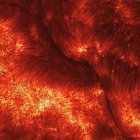|
Galaxies thread
|
|
| SpaceEngineer | Date: Saturday, 13.10.2012, 23:22 | Message # 16 |
 Author of Space Engine
Group: Administrators
 Russian Federation
Russian Federation
Messages: 4800
Status: Offline
| Quote (HarbingerDawn) Sirius is quite visible to most of the northern hemisphere. But most of the best stuff is in the southern sky.
But Canopus, the second brightest star, isn't.
I live at 60° north, so Galaxy center is below the horizon. Taking into account that the best time to observe the Milky Way here is in August and September, and the nights are still quite light, and has huge light pollution, I almost never see the Galaxy center from my city. But I do see this at Kavkaz, when I go to the SAO observatory. There is a huge number of nebulae that can be seen with the naked eye. The Milky Way is the most beautiful sight when seen in Earth's sky.
BTW, which of you guys have ever seen an aurora? I was born and lived my childhood in Murmansk, a north city at 69°, and my best childhood astronomical recall is a bright beautiful aurora, that can be seen often there.
*

|
| |
| |
| Martek | Date: Sunday, 14.10.2012, 04:33 | Message # 17 |
 Astronaut
Group: Users
 United States
United States
Messages: 76
Status: Offline
| I am at 32N, I wish to see the LMC and SMC so bad! I wonder how bright there are! Does anyone know? I haven't seen a nice photo of them without exposure. I'd imagine they are brighter than the Milky Way core though, right?
5.0 GHz i7 12 Cores
GeForce 680i GTX 2GB
Windows 7 Ultimate
64GB DDR3 RAM
|
| |
| |
| HarbingerDawn | Date: Sunday, 14.10.2012, 05:17 | Message # 18 |
 Cosmic Curator
Group: Administrators
 United States
United States
Messages: 8717
Status: Offline
| Quote (Martek) I haven't seen a nice photo of them without exposure
There's no such thing as a photo without exposure. A photo IS an exposure.
Based on images I've seen, they are probably about as bright as an average section of the Milky Way.
All forum users, please read this!
My SE mods and addons
Phenom II X6 1090T 3.2 GHz, 16 GB DDR3 RAM, GTX 970 3584 MB VRAM
|
| |
| |
| HarbingerDawn | Date: Tuesday, 30.10.2012, 00:16 | Message # 19 |
 Cosmic Curator
Group: Administrators
 United States
United States
Messages: 8717
Status: Offline
| The Large and Small Magellanic Clouds may have collided around 300 million years ago, as evidenced by an apparent stream of stars that LMC stole from SMC.
http://www.space.com/18277-m....rs.html
All forum users, please read this!
My SE mods and addons
Phenom II X6 1090T 3.2 GHz, 16 GB DDR3 RAM, GTX 970 3584 MB VRAM
|
| |
| |
| Solaris | Date: Tuesday, 06.11.2012, 01:39 | Message # 20 |
 World Builder
Group: Global Moderators
 France
France
Messages: 731
Status: Offline
| Interesting simulation :
|
| |
| |
| Disasterpiece | Date: Tuesday, 06.11.2012, 04:42 | Message # 21 |
 World Builder
Group: Users
 United States
United States
Messages: 640
Status: Offline
| I went to Yosemite and that was the first time I could see the galactic center.
I play teh spase engien
|
| |
| |
| Destroyer123 | Date: Tuesday, 06.11.2012, 08:01 | Message # 22 |
|
Astronaut
Group: Users
 Sweden
Sweden
Messages: 64
Status: Offline
| HarbingerDawn, cool that means that the first ancestors of the dinosaurs would have seen them collide or something?
"Somewhere something incredibly is wating to be known"
Carl sagan
|
| |
| |
| HarbingerDawn | Date: Thursday, 08.11.2012, 07:56 | Message # 23 |
 Cosmic Curator
Group: Administrators
 United States
United States
Messages: 8717
Status: Offline
| Not galaxy-related per se, but it's close enough.
A study of the rates of star formation across the history of the universe shows that the rate of star formation has been declining for the past 11 billion years or so and is currently just 3% of its ancient peak. Furthermore, if the present rate of decline continues, then that means that over 95% of all stars that will ever exist have already been born.
Space.com article: http://www.space.com/18370-universe-star-formation-rate-decline.html

All forum users, please read this!
My SE mods and addons
Phenom II X6 1090T 3.2 GHz, 16 GB DDR3 RAM, GTX 970 3584 MB VRAM
|
| |
| |
| HarbingerDawn | Date: Thursday, 15.11.2012, 22:59 | Message # 24 |
 Cosmic Curator
Group: Administrators
 United States
United States
Messages: 8717
Status: Offline
| A new galaxy discovered by Hubble is the most distant yet seen at 13.3 billion years ago, just 420 million years after the Big Bang. Its light was lensed by a galaxy cluster into multiple images.

NASA release: http://www.nasa.gov/mission_pages/hubble/science/distance-record.html
Space.com article: http://www.space.com/18502-f....os.html
Hubblesite.org: http://hubblesite.org/newscenter/archive/releases/2012/36
ESA's Hubble site: http://www.spacetelescope.org/news/heic1217/
All forum users, please read this!
My SE mods and addons
Phenom II X6 1090T 3.2 GHz, 16 GB DDR3 RAM, GTX 970 3584 MB VRAM
|
| |
| |
| HarbingerDawn | Date: Friday, 11.01.2013, 22:27 | Message # 25 |
 Cosmic Curator
Group: Administrators
 United States
United States
Messages: 8717
Status: Offline
| The Milky Way galaxy may be less massive than previously thought, based on observations of stars in the outer halo (250 000 - 500 000 light years from the galactic center). Those observations suggest that the Milky Way is between 500 billion and 1 trillion Solar masses. However, stars in that region of the halo have poorly characterized orbits and it is still possible that the Milky Way may be more massive than this study suggests, as was previously thought.
Space.com article
All forum users, please read this!
My SE mods and addons
Phenom II X6 1090T 3.2 GHz, 16 GB DDR3 RAM, GTX 970 3584 MB VRAM
|
| |
| |
| Dwarden | Date: Thursday, 25.04.2013, 15:21 | Message # 26 |
 Astronaut
Group: SE team
 Czech Republic
Czech Republic
Messages: 63
Status: Offline
| http://www.spacetelescope.org/news/heic1308/

Quote
When galaxies form new stars, they sometimes do so in frantic episodes of activity known as starbursts. These events were commonplace in the early Universe, but are rarer in nearby galaxies.
During these bursts, hundreds of millions of stars are born, and their combined effect can drive a powerful wind that travels out of the galaxy. These winds were known to affect their host galaxy — but this new research now shows that they have a significantly greater effect than previously thought.
An international team of astronomers observed 20 nearby galaxies, some of which were known to be undergoing a starburst. They found that the winds accompanying these star formation processes were capable of ionising [1] gas up to 650 000 light-years from the galactic centre — around twenty times further out than the visible size of the galaxy. This is the first direct observational evidence of local starbursts impacting the bulk of the gas around their host galaxy, and has important consequences for how that galaxy continues to evolve and form stars.
Ideas are like ocean w/o borders! https://twitter.com/FoltynD
|
| |
| |
| HarbingerDawn | Date: Thursday, 25.04.2013, 15:24 | Message # 27 |
 Cosmic Curator
Group: Administrators
 United States
United States
Messages: 8717
Status: Offline
| Dwarden, a thread about galaxies already exists.
All forum users, please read this!
My SE mods and addons
Phenom II X6 1090T 3.2 GHz, 16 GB DDR3 RAM, GTX 970 3584 MB VRAM
|
| |
| |
| Crashman1390 | Date: Friday, 26.04.2013, 04:31 | Message # 28 |
 Explorer
Group: Users
 Canada
Canada
Messages: 229
Status: Offline
| Well... I now know that spiral galaxies today can have no gas:

[b]I was wrong, this forum still has a horrible community.[/b]
Edited by Crashman1390 - Friday, 26.04.2013, 04:31 |
| |
| |
| Salvo | Date: Wednesday, 31.07.2013, 14:56 | Message # 29 |
 Star Engineer
Group: Local Moderators
 Italy
Italy
Messages: 1400
Status: Offline
| A new stunning image of Andromeda Galaxy *-*

The universe is not required to be in perfect harmony with human ambition.
CPU: Intel Core i7 4770 GPU: ASUS Radeon R9 270 RAM: 8 GBs
(still don't know why everyone is doing this...)
Edited by Salvo - Wednesday, 31.07.2013, 16:02 |
| |
| |
| HarbingerDawn | Date: Wednesday, 31.07.2013, 15:20 | Message # 30 |
 Cosmic Curator
Group: Administrators
 United States
United States
Messages: 8717
Status: Offline
| Salvo, there is already a galaxy thread here.
All forum users, please read this!
My SE mods and addons
Phenom II X6 1090T 3.2 GHz, 16 GB DDR3 RAM, GTX 970 3584 MB VRAM
|
| |
| |